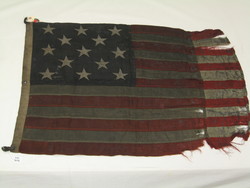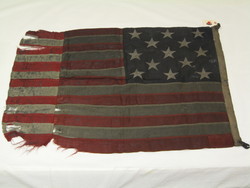13 Star U.S. Navy Boat Flag - #11, N.Y. - Decatur Family Collection.
This is a wool machine sewn US Navy Boat Ensign. It is stenciled the hoist "US Boat Flag, Navy Yard New York No. 11, April 1913", This design was abolished in 1916. The flag is well worn and exhibits numerous period repairs along the fly edge where a portion of all of the stripes have been replaced with patching, a common method for extending the life of these flags.
In 1798, after previously disbanding the Continental Navy of the Revolutionary Era, the US Congress reestablished a permanent navy for the United States. This force followed the traditions of navies the world over of using a national ensign on warships, and smaller versions of the same on small boats, gigs and harbor craft.
From 1795 until 1818 the US Flag bore 15 stars and 15 stripes, and the US ensign, a national flag flown at sea, followed suit. But, the addition of new states that were not represented on the Stars & stripes eventually rendered these flags and ensigns inaccurate.
In 1818 the Third Flag Act corrected this by restoring the ensign to 13 stripes, but also allowed for the addition of new stars to the canton upon the admission of new territories to full statehood. This was to officially occur on the next July the fourth following a new states admission to the Union.
The period from 1818 to 1851 was a very dynamic time for the United States. In these 32 years 12 states were added to Union; changing the ensigns equal number of times. This required the continuous alteration of outdated ensigns.
The US Navy made its own ensigns, flags and pennants in flag lofts at the various yards under its control, generally employing local seamstresses, often the wives and widows of seamen. They would make flags according to Circulars handed down from the Secretary of the Navy as to how the stars should be arranged upon the canton of the ensign. When a new one arrived detailing the arrangement of stars, the new pattern was made, although in the absence of a circular, artistic license was not unknown. Flags on vessels at sea were altered by the ships sailmakers and their mates by the addition of the appropriate number of stars. Further complicating the matter was the omission of sizes in the circulars; leaving each Commodore to create his own specified sizes. In the early 19th century it was a common, if unofficial, naval practice to make a sailing ships ensign equal to its breadth. However, the sizes of flags for small boats varied according to the preferences of the captain.
The small size of the navy allowed for easy compliance with little thought given to the cost; but, after the Mexican-American War in 1848 and the admission of California to statehood in 1851 the navy began to expand into a two ocean navy. It was in this era and probably as a cost cutting measure, but possibly because the stars would be larger, and therefore more visible, that the US Navy officially began reducing the number of stars on ensigns on small boats. Although there is some speculation, based upon nautical paintings, that this practice was already accepted if unofficial
The exact dates of this practice are uncertain; as there is preserved in the collections of the US Naval Academy a small boat ensign from Perry's 1853 visit to Japan that bears the full complement of 31 stars, presumably supplied by the flag loft at his embarkation point of Norfolk, Virginia; however, official preparations for the expedition to Japan commenced in 1851. Conversely, there is also a 16 star boat ensign marked NYC (Navy Yard Charleston outside Boston) which is dated 1857. Presumably the practice did not occur all at once, but was implemented over time on different vessels and at different yards
The surviving records are incomplete but based upon surviving flags, paintings and photographic evidence, we may deduce the following:
∗ From its beginnings the US Navy used small ensigns on smaller boats & gigs.
∗ They could have either 13 stars or the correct star count.
∗ About the time of the War with Mexico the Navy began to reduce the number of stars on small boat ensigns.
∗ The first known USN Table of Sizes is dated 1854.
∗ This practice was official by the late 1850s.
∗ Initially the number of stars either 20, 16, or 13 stars arranged either in rows of 5-5-5-5 or 4-4-4-4, or 4-5-4 respectively.
∗ Eventually the number was standardized at 13 stars.
∗ In the 1850s US Navy reintroduced the 1770s pattern of rows of 4-5-4 stars.
∗ In the 1860s they reintroduced another Revolutionary War pattern, of 3-2-3-2-3.
∗ The 4-5-4 and the 3-2-3-2-3 pattern flew concurrently during the Civil War.
∗ Probably because of supplies on hand the 4-5-4 continued into the 1870s
∗ In the mid 1870s the use of the 4-5-4 was discontinued.
∗ Then 3-2-3-2-3 pattern would continue in use until 1916.
From the 1870s until 1916 we may observe the following pattern:
∗ 1870s-1885 - stars in canton do not "point" in any consistent direction.
∗ 1882-1890 markings start to appear regularly on heading lists the size of the flag, e.g. US Ensign", "U.S.E. No. 8" (a date); brass grommets replace hand whipped button holes or plain grommets.
∗ 1890-1900 - stars are oriented in common directions; rows of 3 "up," rows of 2, "down;" the heading is now marked with size, location of navy yard where the flag was made and the date (month/year) of production.
∗ 1900-1916 - stars all oriented "up," dates no longer appear on brass grommets, stars applied to canton with machine, zig-zag stitch.
Since 1916 the small boat flags of the US Navy have displayed the full complement of 48, 49 or 50 stars.
This flag was formerly part of the Decatur-Armsden Collection; a family collection that included artifacts and flags from the Lear-Storer-Decatur family which encompassed a number of important historical figures from the 19th, 18th and 17th Centuries.
This cache of historical goods descended from various branches of the Lear-Storer-Decatur family and included items from Sir William Pepperrell Baronet and John Storer ( who were both part of the 1745 expedition to Nova Scotia capture Ft. Louisburg), Colonel Tobias Lear (General Washington's Aide de Camp and personal friend), of Benjamin Lincoln Lear (son of Tobias Lear), Commodore Stephen Decatur (nephew of his famous namesake Commodore Stephen Decatur, 1779-1820), Rear Admiral George Washington Storer (nephew of Tobias Lear, 1789-1864), Ichabod Goodwin ( Governor of New Hampshire), and Admiral of the Navy George Dewey.
The accumulation of historic artifacts was a treasure trove which was rediscovered in the mid 20th Century when the family as a whole decided to sell a barn at Kittery Point, Maine, the spiritual ecumene of the extended family. The barn had served as a repository for a vast amount of historical material that has been passed down through the generations. When inventoried the barn was found to contain a significant archive of papers, memorabilia, photographs, books, artifacts and twenty historic flags. The historic trove was divided up amongst the three branches of the family.
That portion which had gone to Alice Decatur Armsden contained the flags and was maintained in its entirety until her and her husband's estate was settled in 2009. In the estate were flags from some of America's most illustrious naval families Decatur, Storer and Dewey. The flag grouping consisted of Boat Flags, Ensigns, Signal Flags, Burgees, Rank Flags, Distinguishing Flags, Service Flags and a Yacht Ensign. Among the US flags and ensigns were the following star counts; 13 stars (4), 16 stars, 26 stars, 34 stars (3), 35 stars, 45 stars (2) and 48 stars.
Dating from the early 18th to the early 20th century, the flags were acquired from the male naval officers of the family and preserved by the women of the families; notably Anna Rowell Philbrick Decatur (1821-1906), the wife of Stephen Decatur and Mable Storer, wife of Rear Admiral Storer, who carefully preserved and conserved these flags, and act for which posterity is forever indebted.
Provenance: Acquired at auction, 2-Day Winter Antiques & Fine Art Auction, 4-5 February 2010, James D. Julia, Fairfield, ME.
ZFC Significant Flag
Sources:
Madaus, Howard M.- Whitney Smith, The American Flag: Two Centuries of Concord and Conflict, VZ Publications, Santa Cruz, 2006.
US Navy "Boat" Flag , Dave Martucci's Flag Pages, 10 October 2011, from: http://www.vexman.net/smalboat.htm
Image Credits:
Zaricor Flag Collection



























